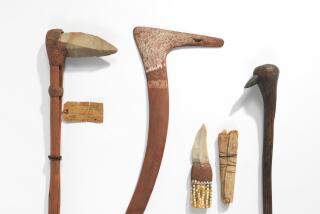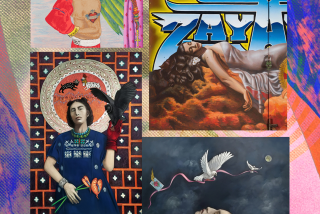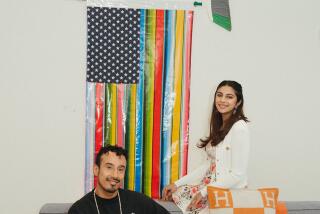Cheery Brazilian Works Reveal Spirit of Survival
At a glance, the current exhibition of Brazilian popular art at UCLA’s Fowler Museum looks like your usual jolly strew of folk imagery. No amount of scrutiny changes that celebratory spirit. Concentration does, however, reveal the adamant buoyancy its artists need to maintain their sense of fun.
“O Pelourinho! Popular Art From the Historic Heart of Brazil” is a traveling exhibition of 61 contemporary paintings and textiles plus 25 sculptures. It was put together by co-curators Marion Jackson of Wayne State University and Barbara Cervenka of the University of Michigan.
The work comes from Brazil’s first colonial capital, Salvador, in the state of Bahia. The town’s old central city is known as the Pelourinho. Founded by the Portuguese in 1549, it preceded the settlement of North America by nearly 50 years. For the next three centuries, the port acted as the debarkation point for an estimated 4 million African slaves. Their descendants are the makers of this art.
Today the Pelourinho is a colorful tourist attraction, revivified in the ‘70s after decades of neglect, crime and prostitution. Its blue colonial cathedral sits on the main square radiating winding alleys and warrens of pretty dwellings up the surrounding hills. The site acts as background for much of this art. This is the kind of stuff that gives picturesque a good name.
At the same time, the surrounding Northeastern Brazilian region, plagued by drought and crop failure, is the poorest part of the country, its black and mixed-race population the most bereft of the downtrodden. To survive that, a person needs large reserves of faith, hope and humor.
Which undoubtedly accounts for the persistence of Catholicism and its blending with the traditional belief of the slave population, the Candomble. It supports a pantheon of spirits called the orixas. Artists such as Eduardo Santos Silva depict Candomble rituals acted out in exotic costumes that appear grounded in pre-Columbian prototypes. Accessories include ornate knives, bows and arrows plus live snakes. Dancing and incantations induce an ecstatic trance in votaries who feel the spirits have entered them.
Jose Adario makes ferramentas--religious objects associated with the rituals. Fashioned of iron, some represent devils of both genders, odd nonfunctional candelabra of pitchfork shapes or curious amalgamations of hanging objects suggesting jail keys. It’s hard to avoid the suggestion that the ironworks refer back to the days when the Pelourinho square was the place where slaves were publicly tortured.
In his 70s, Alfredo Cruz has been a street sweeper all his working life and is counted among the area’s veteran artists. His folk-style compositions seem perfectly good-natured, but look again. One untitled scene depicts the whipping of a slave. Another shows a popular folk hero attacking a group of soldiers. Cruz smiles but there is no love lost on the enforcers employed by the rich.
Jota Cunha--evidently a younger and more sophisticated artist--gets conceptual in poster-like compositions that rework airport graphics. They show cheery stuff like dancers and steel bands, but in the center of one, the circled word “Racism” is crossed out.
Overridingly, however, the art not only expresses a love of life and land, it regularly outstrips its own traditional limitations. A countryside scene by Raimundo Santos, for example, depicts an Edenic village on a riverbank. Kids, pigs, moms, banana trees and river are shown in the usual limpid turquoise and lime greens. Shapes are in the expected flat folk style. Suddenly, however, the whole thing takes on magical dimension. It somehow manages to represent deep space.
An artist called Totonho manages the same effect in a close-up of a contorted tree trunk and multicolored parrots. Such works are like flat-painted animation cells that achieve an optical sophistication that makes them appear fully modeled. Raimundo Nonato gets at another sort of aesthetic elegance in an image of a church and multiple brides, all rendered against black with bead-like dots. Goya Lopes makes fabric banners that combine decorative elan with a startling command of geometric illusionism. It’s nice to encounter an exhibition that’s better than its own modest aims.
* UCLA Fowler Museum of Cultural History; to May 10, closed Monday and Tuesday, (310) 825-4361.
More to Read
The biggest entertainment stories
Get our big stories about Hollywood, film, television, music, arts, culture and more right in your inbox as soon as they publish.
You may occasionally receive promotional content from the Los Angeles Times.










